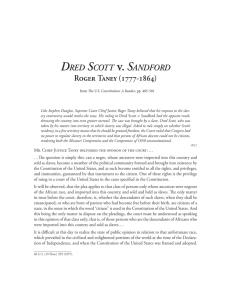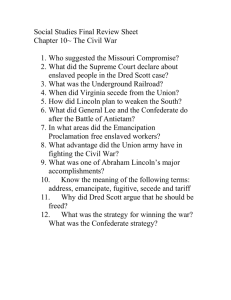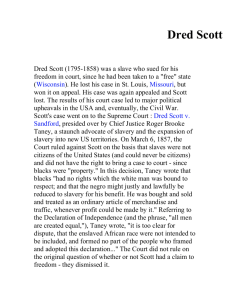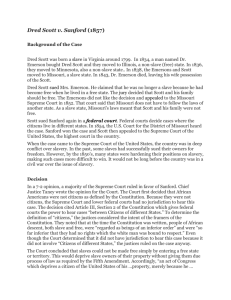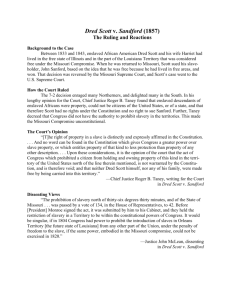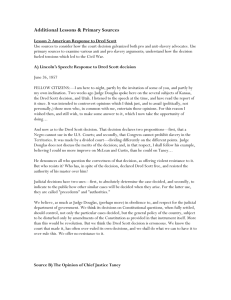The Dred Scott Decision - Maryland State Department of Education
advertisement
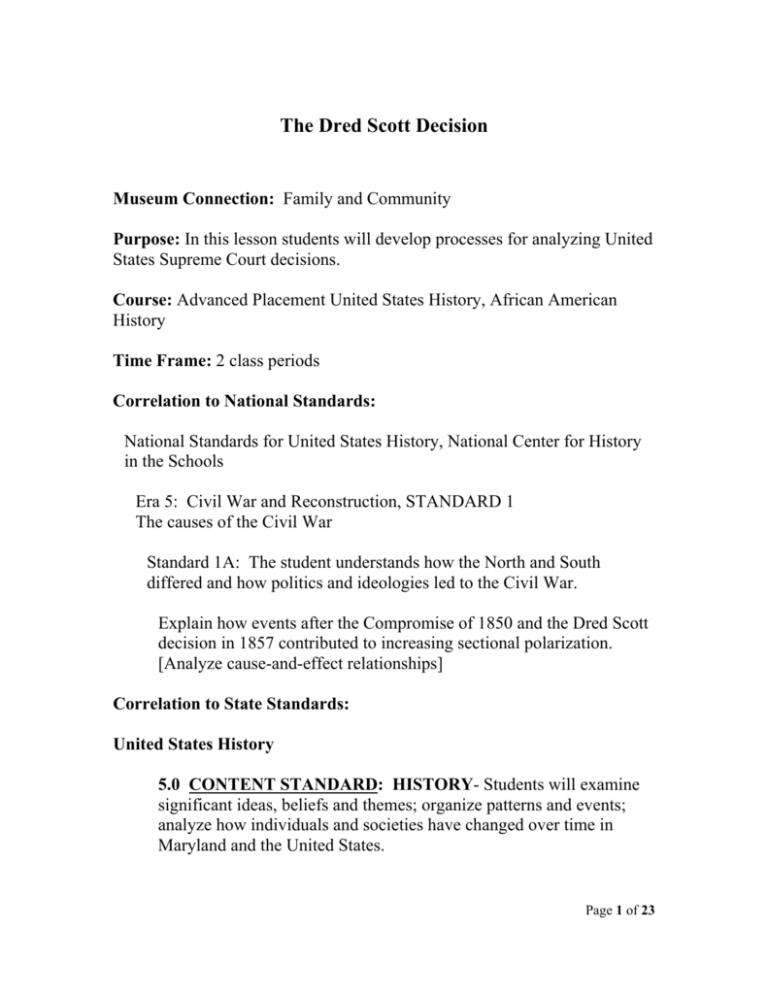
The Dred Scott Decision Museum Connection: Family and Community Purpose: In this lesson students will develop processes for analyzing United States Supreme Court decisions. Course: Advanced Placement United States History, African American History Time Frame: 2 class periods Correlation to National Standards: National Standards for United States History, National Center for History in the Schools Era 5: Civil War and Reconstruction, STANDARD 1 The causes of the Civil War Standard 1A: The student understands how the North and South differed and how politics and ideologies led to the Civil War. Explain how events after the Compromise of 1850 and the Dred Scott decision in 1857 contributed to increasing sectional polarization. [Analyze cause-and-effect relationships] Correlation to State Standards: United States History 5.0 CONTENT STANDARD: HISTORY- Students will examine significant ideas, beliefs and themes; organize patterns and events; analyze how individuals and societies have changed over time in Maryland and the United States. Page 1 of 23 Expectation 5.1: Students will demonstrate understanding of the cultural, economic, political, social and technological developments from Reconstruction to 1897 1. Analyze the economic, political and social consequences of Reconstruction (5.1.1). Objective: Analyze the practices, policies and legislation used to deny African-Americans’ civil rights, including black codes, lynching, the Ku Klux Klan, voting restrictions, Jim Crow Laws and Plessy v. Ferguson (1896) (PS, PNW, E) Common Core State Reading Standards for Literacy in History/Social Studies 6-12 • Cite specific textural evidence to support analysis of primary and secondary sources, attending to such features as the date and origin of the information. Common Core State Writing Standards for Literacy in History/Social Studies 6-12 • Write informative/explanatory texts, including the narration of historical events, scientific procedures/experiments, or technical processes. • Draw evidence from informational texts to support analysis, reflection, and research. Objective: Students will analyze the Supreme Court’s decision in Dred Scott v. Sanford and explain its role in increasing tensions that led to the Civil War. Page 2 of 23 Vocabulary and Concepts: Territory an area of land under the jurisdiction of a governmental authority. Territory can, though, include any geographical area under the jurisdiction of a sovereign and does not have a political division status. The remainder of this article deals with political territories. State a state is a set of institutions that possesses the exclusive legitimate authority to make the rules that govern the people in one or more societies, having internal and external sovereignty over a definite territory. Missouri admitted Maine as a free state and Missouri as a slave Compromise state but prohibited slavery about the line of 36 degrees 30 minutes North latitude. Emancipation the act of freeing someone from control of another. Jurisdiction the authority of a court to rule on certain issues. To reverse a overturn a previous legal decision or case or law. decision Majority opinion when the majority of the judges agree on the facts of the case. Concurring opinion the written explanation of the views of one or more judges who support a decision reached by a majority of the court but wish to add or emphasize a point that was not made in the majority decision. Dissenting opinion written explanation of the views of one or more judges who disagree with (dissent from) a decision reached by a majority of the court. Materials: For the Teacher: Student Resource Sheet 1, Can a Negro? Student Resource Sheet 2, The language of the Declaration Page 3 of 23 Student Resource Sheet 3, It would be impossible Student Resource Sheet 4, Here the line of distinction Student Resource Sheet 5, In the legislative debates Student Resource Sheet 6, On the 25th of June Student Resource Sheet 7, Citizens of the United States For the Student: Student Resource Sheet 1, Can a Negro? Student Resource Sheet 2, The language of the Declaration Student Resource Sheet 3, It would be impossible Student Resource Sheet 4, Here the line of distinction Student Resource Sheet 5, In the legislative debates Student Resource Sheet 6, On the 25th of June Student Resource Sheet 7, Citizens of the United States Historical Background: Dred Scott first went to trial to sue for his freedom in 1847. Ten years later, after a decade of appeals and court reversals, his case was finally brought before the United States Supreme Court. In what was one of the most famous decisions in its history at the time, the Court decided that all descendents of African slaves -- slaves as well as those who were free -could never become citizens of the United States and therefore could not sue in federal court. The Court also ruled that the federal government did not have the power to prohibit slavery in its territories. Scott, needless to say, remained a slave. Born around 1800, Scott migrated westward with his master, Peter Blow. They traveled from Scott's home state of Virginia to Alabama and then, in 1830, to St. Louis, Missouri. Two years later, Peter Blow died; Scott was subsequently bought by army surgeon Dr. John Emerson, who later took Scott to the free state of Illinois. In the spring of 1836, after a stay of two and a half years, Emerson moved to a fort in the Wisconsin Page 4 of 23 Territory, taking Scott along. While there, Scott met and married Harriet Robinson, a slave owned by a local justice of the peace. Ownership of Harriet was then transferred to Emerson. Scott's extended stay in Illinois, a free state, gave him the legal standing to make a claim for freedom, as did his extended stay in Wisconsin where slavery was also prohibited. But Scott never made the claim while living in the free lands -- perhaps because he was unaware of his rights at the time, or perhaps because he was content with his master. After two years, the army transferred Emerson: first to St Louis, then to northern part of Louisiana where slavery had been excluded as part of the Missouri Compromise. A little over a year later, a recently-married Emerson summoned his slave couple. Instead of staying in the free territory of Wisconsin, or going to the free state of Illinois, the two traveled over a thousand miles, apparently unaccompanied, down the Mississippi River to meet their master. Only after Emerson's death in 1843, and after Emerson's widow hired Scott out to an army captain, did Scott seek freedom for himself and his wife. First he offered to buy his freedom from Mrs. Emerson -- then living in St. Louis -for $300. The offer was refused. Scott then sought freedom through the courts. Scott went to trial in June of 1847, but lost on a technicality -- he couldn't prove that he and Harriet were owned by Emerson's widow. The following year the Missouri Supreme Court decided that the case should be retried. In an 1850 retrial, the St. Louis Circuit Court ruled that Scott and his family were free. Two years later the Missouri Supreme Court stepped in again, reversing the decision of the lower court. Scott and his lawyers then brought his case to a federal court, the United States Circuit Court in Missouri. In 1854, the Circuit Court upheld the decision of the Missouri Supreme Court maintaining Scott’s slave status. There was now only one other place to go. Scott appealed his case to the United States Supreme Court. The nine justices of the Supreme Court of 1856 certainly had pro-slavery biases. Seven had been appointed by pro-slavery presidents from the South, and of these, five were from slave-holding families. Still, if the case had gone directly from the state Supreme Court to the federal Supreme Court, the federal court probably would have upheld the state's ruling, citing a previously established decision that gave states the authority to determine Page 5 of 23 the status of its inhabitants. But, in his attempt to bring his case to the federal courts, Scott had claimed that he and the case's defendant (Mrs. Emerson's brother, John Sanford, who lived in New York) were citizens from different states. The main issues for the Supreme Court, therefore, were whether it had jurisdiction to try the case and whether Scott was indeed a citizen. The case hinged on two leading questions: (1) Did the Circuit Court of the United States have jurisdiction to hear and rule on the dispute between these parties? (2) If it had jurisdiction, is the judgment it has given erroneous or not? The decision of the court was read in March of 1857. Chief Justice Roger B. Taney--a staunch supporter of slavery although he had freed his own slaves-- wrote the majority opinion for the court. It stated that because Scott was African American he was not a citizen and therefore had no right to sue. The decision also declared the Missouri Compromise of 1820, legislation which restricted slavery in certain territories, unconstitutional. Referring to the language in the Declaration of Independence that includes the phrase, "all men are created equal," Taney reasoned that "it is too clear for dispute, that the enslaved African race were not intended to be included, and formed no part of the people who framed and adopted this declaration. . . ." While the Dred Scott decision was well-received by slaveholders in the South, many northerners were outraged. The case strengthened the Republican Party, which in 1860 nominated Abraham Lincoln for President. As a result of his staunch opposition to the expansion of slavery into U.S. territories, Lincoln’s election resulted in the secession of southern states from the Union and civil war. Peter Blow's sons, childhood friends of Scott, had helped pay Scott's legal fees that had accumulated throughout his legal battles. After the Supreme Court's decision, the former master's sons purchased Scott and his wife and set them free. Dred Scott died nine months later. Schultze, Louis. Dred Scott. Missouri Historical Society. St. Louis Page 6 of 23 Resources: Web Sites http://www.landmarkcases.org/dredscott/majority.html http://www.nps.gov/archive/jeff/dred_scott.html http://www.pbs.org/wgbh/aia/part4/4h2933.html http://www.pbs.org/wgbh/aia/part4/4h1532.html Lesson Development: Motivation: 1. Ask students to recall the quote from the Declaration of Independence describing the equality of all people. Ask: Who were the groups who may not have been considered “equal’? Why? 2. Review the events leading to Dred Scott v. Sanford using text references, referring to the Historical Background information in this lesson plan as needed. Use probing questions so that students identify the question of Scott’s citizenship as the essential issue before the Supreme Court. Have students brainstorm arguments that could be made on behalf of Scott that could convince the Supreme Court that Scott had the right to sue for his freedom. List student responses for future reference. 3. Distribute the following resource sheets randomly so that each student has one copy. Inform students that each resource sheet provides text from an opinion by one or more Supreme Court Justices who heard Dred Scott v. Sanford. Student Resource Sheet 1, Can a Negro? Student Resource Sheet 2, The language of the Declaration Student Resource Sheet 3, It would be impossible Student Resource Sheet 4, Here the line of distinction Student Resource Sheet 5, In the legislative debates Page 7 of 23 Student Resource Sheet 6, On the 25th of June Student Resource Sheet 7, Citizens of the United States Direct students to compare the opinions on each resource sheet with the list of arguments they generated earlier. Have students create a graphic organizer that demonstrates the conflicting arguments of the case. 4. Conclude by revealing that Resource Sheets 1, 2, 3, and 4 are from the majority opinion that ruled that African Americans were not citizens and could not sue in court. Further inform students that two justices dissented and that Resource Sheets 5, 6, and 7 are from the dissenting opinion written by Justice Curtis. Assessment: Assess students’ abilities to analyze the Dred Scott decision by identifying other benefits of citizenship that could be denied because of this ruling. Closure: Instruct students to create a timeline of events that lead up to the Civil War, 1857-1861. Ask students to identify which of these events can be traced directly back to the Dred Scott Case or decision. Lesson Extensions • The Reginald F. Lewis Museum of Maryland African American History & Culture offers several school programs that connect to the curriculum lessons: o Journey in History Theater provides living history and theatrical performances which highlight African Americans in the museum’s gallery. o Take the theme tour, Paths to Freedom and explore the story of slavery through the eyes of enslaved and free blacks from Maryland’s colonial past to the end of the Civil War. • Contact group reservations for schedule updates. Page 8 of 23 • Visit the Museum to view exhibits that tell the story of slavery and freedom in Maryland. • Imagine that you are an African American abolitionist living in the North and you hear about the Supreme Court’s decision on the Dred Scott case. Write a letter stating your reactions to the case based on the court’s findings. • Imagine that you are an African American abolitionist living in the North and you hear about the Supreme Court’s decision on the Dred Scott case. Write a letter stating your reactions to the case based on the court’s findings. • Discuss Frederick Douglass’ reactions to the Supreme Court’s decision. How did he think it would affect slavery? • View the film, Amistad. Determine why the Supreme Court decided in favor of the West Africans in this legal judgment. Compare this case with Dred Scott. What factors made the Dred Scott case different? Page 9 of 23 Student Resource Sheet 1 Can a Negro? Excerpt from the Supreme Court’s Decision in Dred Scott v. Sanford (1857) “… The plaintiff [Dred Scott]... was, with his wife and children, held as slaves by the defendant [Sanford], in the State of Missouri; and he brought this action in the Circuit Court of the United States for [Missouri], to assert the title of himself and his family to freedom. The declaration is . . . that he and the defendant are citizens of different States; that... he is a citizen of Missouri, and the defendant a citizen of New York. “The question is simply this: Can a negro, whose ancestors were imported into this country, and sold as slaves, become a member of the political community formed and brought into existence by the Constitution of the United States, and as such become entitled to all the rights, and privileges, and immunities, guarantied by that instrument to the citizen? One of which rights is the privilege of suing in a court of the United States in the cases specified in the Constitution.... “The words "people of the United States" and "citizens" are synonymous terms, and mean the same thing. They both describe the political body who ... form the sovereignty, and who hold the power and conduct the Government through their representatives.... The question before us is, whether the class of persons described in the plea in abatement [people of African ancestry] composes a portion of this people, and are constituent members of this sovereignty? We think they are not, and that they are not included, and were not intended to be included, under the word "citizens" in the Constitution, and can therefore claim none of the rights and privileges which that instrument provides for and secures to citizens of the United States. On the contrary, they were at that time considered as a subordinate and inferior class of beings, who had been subjugated by the dominant race, and, whether emancipated or not, yet remained subject to their authority, and had no rights or privileges but such as those who held the power and the Government might choose to grant them. Page 10 of 23 “The court thinks the affirmative of these propositions cannot be maintained. And if it cannot, [Dred Scott] could not be a citizen of the State of Missouri, within the meaning of the Constitution of the United States, and, consequently, was not entitled to sue in its courts. It is true, every person, and every class and description of persons, who were at the time of the adoption of the Constitution recognized as citizens in the several States, became also citizens of this new political body; but none other; it was formed by them, and for them and their posterity, but for no one else. And the personal rights and privileges guarantied to citizens of this new sovereignty were intended to embrace those only who were then members of the several State communities, or who should afterwards by birthright or otherwise become members, according to the provisions of the Constitution and the principles on which it was founded.... “It becomes necessary, therefore, to determine who citizens of the several States were when the Constitution was adopted....... [T]he legislation and histories of the times, and the language used in the Declaration of Independence, show, that neither the class of persons who had been imported as slaves, nor their descendants, whether they had become free or not, were then acknowledged as a part of the people, nor intended to be included in the general words used in that memorable instrument. “It is difficult at this day to realize the state of public opinion in relation to that unfortunate race, which prevailed in the civilized and enlightened portions of the world at the time of the Declaration of Independence.” Page 11 of 23 Student Resource Sheet 2 The language of the Declaration Excerpt from the Supreme Court’s Decision in Dred Scott v. Sanford (1857) “… The language of the Declaration of Independence is equally Conclusive: …We hold these truths to be self-evident: that all men are created equal; that they are endowed by their Creator with certain unalienable rights; that among them is life, liberty, and the pursuit of happiness; that to secure these rights, Governments are instituted, deriving their just powers from the consent of the governed. “The general words above quoted would seem to embrace the whole human family, and if they were used in a similar instrument at this day would be so understood. But it is too clear for dispute, that the enslaved African race were not intended to be included, and formed no part of the people who framed and adopted this declaration; for if the language, as understood in that day, would embrace them, the conduct of the distinguished men who framed the Declaration of Independence would have been utterly and flagrantly inconsistent with the principles they asserted; and instead of the sympathy of mankind, to which they so confidently appeared, they would have deserved and received universal rebuke and reprobation. “Yet the men who framed this declaration were great men -- high in literary acquirements -- high in their sense of honor, and incapable of asserting principles inconsistent with those on which they were acting. They perfectly understood the meaning of the language they used, and how it would be understood by others; and they knew that it would not in any part of the civilized world be supposed to embrace the negro race, which, by common consent, had been excluded from civilized Governments and the family of nations, and doomed to slavery. They spoke and acted according to the then established doctrines and principles, and in the ordinary language of the day, no one misunderstood them. The unhappy black race were separate from white by indelible marks, and laws long before established, and were never thought of or spoken of except as property, and when the claims of the owner or the profit of the trader were supposed to need protection. Page 12 of 23 “This state of public opinion had undergone no change when the Constitution was adopted, as is equally evident from its provisions and language....[There] are two clauses in the Constitution which point directly and specifically to the negro race as a separate class of persons, and show clearly that they were not regarded as a portion of the people or citizens of the Government then formed. “One of these clauses reserves to each of the thirteen States the right to import slaves until the year 1808.... And by the other provision the States pledge themselves to each other to maintain the fight of property of the master, by delivering up to him any slave who may have escaped from his service, and be found within their respective territories.... And these two provisions show, conclusively, that neither the description of persons therein referred to, nor their descendants, were embraced in any of the other provisions of the Constitution; for certainly these two clauses were not intended to confer on them or their posterity the blessings of liberty, or any of the personal rights so carefully provided for the citizen. “No one of that race had ever migrated to the United States voluntarily; all of them had been brought here as articles of merchandise. The number that had been emancipated at that time were but few in comparison with those held in slavery; and they were identified in the public mind with the race to which they belonged, and regarded as a part of the slave population rather than the free. It is obvious that they were not even in the minds of the framers of the Constitution when they were conferring special rights and privileges upon the citizens of a State in every other part of the Union.” Page 13 of 23 Student Resource Sheet 3 It would be impossible Excerpt from the Supreme Court’s Decision in Dred Scott v. Sanford (1857) “… It would be impossible to enumerate ... the various laws, marking the condition of this race, which were passed from time to time after the Revolution, and before and since the adoption of the Constitution of the United States. In addition to those already referred to, it is sufficient to say, that Chancellor Kent, whose accuracy and research no one will question, states in ... his Commentaries ... that in no part of the country except Maine, did the African race, in point of fact, participate equally with the whites in the exercise of civil and political rights. “The legislation of the States therefore shows, in a manner not to be mistaken, the inferior and subject condition of that race at the time the Constitution was adopted, and long afterwards, . . . and it is hardly consistent with the respect due to these States, to suppose that they regarded at that time, as fellow-citizens and members of the sovereignty, a class of beings whom they had thus stigmatized; ... and upon whom they had impressed such deep and enduring marks of inferiority and degradation; or, that when they met in convention to form the Constitution, they looked upon them as a portion of their constituents, or designed to include them in the provisions so carefully inserted for the security and protection of the liberties and rights of their citizens. It cannot be supposed that they intended to secure to them rights, and privileges, and rank, in the new political body throughout the Union, which every one of them denied within the limits of its own dominion. More especially, it cannot be believed that the large slaveholding States regarded them as included in the word citizens, or would have consented to a Constitution which might compel them to receive them in that character from another State. For if they were so received, and entitled to the privileges and immunities of citizens, it would exempt them from the operation of the special laws and from the police regulations which they considered to be necessary for their own safety. It would give to persons of the negro race, who were recognized as citizens in any one State of the Union, the right to enter every other State whenever they pleased, singly or Page 14 of 23 in companies, without pass or passport, and without obstruction, to sojourn there as long as they pleased, to go where they pleased at every hour of the day or night without molestation, unless they committed some violation of law for which a white man would be punished; and it would give them the full liberty of speech in public and in private upon all subjects upon which its own citizens might speak; to hold public meetings upon political affairs, and to keep and carry arms wherever they went. And all of this would be done in the face of the subject race of the same color, both free and slaves, and inevitably producing discontent and insubordination among them, and endangering the peace and safety of the State. “It is impossible, it would seem, to believe that the great men of the slaveholding States, who took so large a share in framing the Constitution of the United States, and exercised so much influence in procuring its adoption, could have been so forgetful or regardless of “Their own safety and the safety of those who trusted and confided in them…” Page 15 of 23 Student Resource Sheet 4 Here the line of distinction Excerpt from the Supreme Court’s Decision in Dred Scott v. Sanford (1857) “…Here the line of distinction is drawn in express words. Persons of color, in the judgment of Congress, were not included in the word citizens, and they are described as another and different class of persons, and authorized to be employed, if born in the United States.... “The conduct of the Executive Department of the Government has been in perfect harmony upon this subject with this course of legislation. The question was brought officially before the late William Wirt, when he was the Attorney General of the United States, in 1821, and he decided that the words "citizens of the United States" were used in the acts of Congress in the same sense as in the Constitution; and that free persons of color were not citizens, within the meaning of the Constitution and laws; and this opinion has been confirmed by that of the late Attorney General, Caleb Cushing, in a recent case, and acted upon by the Secretary of State, who refused to grant passports to them as "citizens of the United States.... “No one, we presume, supposes that any change in public opinion or feeling, in relation to this unfortunate race, in the civilized nations of Europe or in this country, should induce the court to give to the words of the Constitution a more liberal construction in their favor than they were intended to bear when the instrument was framed and adopted. Such an argument would be altogether inadmissible in any tribunal called on to interpret it. If any of its provisions are deemed unjust, there is a mode prescribed in the instrument itself by which it may be amended; but while it remains unaltered, it must be construed now as it was understood at the time of its adoption. It is not only the same in words, but the same in meaning, and delegates the same powers to the Government, and reserves and secures the same rights and privileges to the citizen; and as long as it continues to exist in its present form, it speaks not only in the same words, but with the same meaning and intent with which it spoke when it came from the hands of its framers, and was voted on and adopted by the people of the United States. Any other rule of Page 16 of 23 construction would abrogate the judicial character of this court, and make it the mere reflex of the popular opinion or passion of the day. This court was not created by the Constitution for such purposes. Higher and graver trusts have been confided to it, and it must not falter in the path of duty.... “And upon a full and careful consideration of the subject, the court is of opinion, that.... Dred Scott was not a citizen of Missouri within the meaning of the Constitution of the United States, and not entitled as such to sue in its courts; and, consequently, that the Circuit Court had no jurisdiction of the case, and that the judgment on the plea in abatement is erroneous....” Page 17 of 23 Student Resource Sheet 5 In the legislative debates Excerpt from Justice Curtis’ Dissenting Opinion in Dred Scott v. Sanford (1857) “…In the legislative debates which preceded the admission of the State of Missouri into the Union, this question was agitated. Its result is found in the resolution of Congress, of March 5, 1821, for the admission of that State into the Union. The Constitution of Missouri, under which that State applied for admission into the Union, provided, that it should be the duty of the Legislature 'to pass laws to prevent free negroes and mulattoes from coming to and settling in the State, under any pretext whatever.' One ground of objection to the admission of the State under this Constitution was, that it would require the Legislature to exclude free persons of color, who would be entitled, under the second section of the fourth article of the Constitution, not only to come within the State, but to enjoy there the privileges and immunities of citizens. The resolution of Congress admitting the State was upon the fundamental condition, 'that the Constitution of Missouri shall never be construed to authorize the passage of any law, and that no law shall be passed in conformity thereto, by which any citizen of either of the States of this Union shall be excluded from the enjoyment of any of the privileges and immunities to which such citizen is entitled under the Constitution of the United States.' It is true, that neither this legislative declaration, nor anything in the Constitution or laws of Missouri, could confer or take away any privilege or immunity granted by the Constitution. But it is also true, that it expresses the then conviction of the legislative power of the United States, that free negroes, as citizens of some of the States, might be entitled to the privileges and immunities of citizens in all the States. “The conclusions at which I have arrived on this part of the case are: First. That the free nativeborn citizens of each State are citizens of the United States. Page 18 of 23 Second. That as free colored persons born within some of the States are citizens of those States, such persons are also citizens of the United States. Third. That every such citizen, residing in any State, has the right to sue and is liable to be sued in the Federal courts, as a citizen of that State in which he resides. Fourth. That as the plea to the jurisdiction in this case shows no facts, except that the plaintiff was of African descent, and his ancestors were sold as slaves, and as these facts are not inconsistent with his citizenship of the United States, and his residence in the State of Missouri, the plea to the jurisdiction was bad, and the judgment of the Circuit Court overruling it was correct. “I dissent, therefore, from that part of the opinion of the majority of the court, in which it is held that a person of African descent cannot be a citizen of the United States;” Page 19 of 23 Student Resource Sheet 6 On the 25th of June Excerpt from the Supreme Court’s Decision in Dred Scott v. Sanford (1857) “…On the 25th of June, 1778, the Articles of Confederation being under consideration by the Congress, the delegates from South Carolina moved to amend this fourth article, by inserting after the word 'free,' and before the word 'inhabitants,' the word 'white,' so that the privileges and immunities of general citizenship would be secured only to white persons. Two States voted for the amendment, eight States against it, and the vote of one State was divided. The language of the article stood unchanged, and both by its terms of inclusion, 'free inhabitants,' and the strong implication from its terms of exclusion, 'paupers, vagabonds, and fugitives from justice,' who alone were excepted, it is clear, that under the Confederation, and at the time of the adoption of the Constitution, free colored persons of African descent might be, and, by reason of their citizenship in certain States, were entitled “to the privileges and immunities of general citizenship of the United States. Did the Constitution of the United States deprive them or their descendants of citizenship? “That Constitution was ordained and established by the people of the United States, through the action, in each State, or those persons who were qualified by its laws to act thereon, in behalf of themselves and all other citizens of that State. In some of the States, as we have seen, colored persons were among those qualified by law to act on this subject. These colored persons were not only included in the body of 'the people of the United States,' by whom the Constitution was ordained and established, but in at least five of the States they had the power to act, and doubtless did act, by their suffrages, upon the question of its adoption. It would be strange, if we were to find in that instrument anything which deprived of their citizenship any part of the people of the United States who were among those by whom it was established. Page 20 of 23 “I can find nothing in the Constitution which, proprio vigore, deprives of their citizenship any class of persons who were citizens of the United States at the time of its adoption, or who should be nativeborn citizens of any State after its adoption; nor any power enabling Congress to disfranchise persons born on the soil of any State, and entitled to citizenship of such State by its Constitution and laws. And my opinion is, that, under the Constitution of the United States, every free person born on the soil of a State, who is a citizen of that State by force of its Constitution or laws, is also a citizen of the United States.” Page 21 of 23 Student Resource Sheet 7 Citizens of the United States Excerpt from Justice Curtis’ Dissenting Opinion in Dred Scott v. Sanford (1857) “…Citizens of the United States at the time of the adoption of the Constitution can have been no other than citizens of the United States under the Confederation. By the Articles of Confederation, a Government was organized, the style whereof was, 'The United States of America.' This Government was in existence when the Constitution was framed and proposed for adoption, and was to be superseded by the new Government of the United States of America, organized under the Constitution. When, therefore, the Constitution speaks of citizenship of the United States, existing at the time of the adoption of the Constitution, it must necessarily refer to citizenship under the Government which existed prior to and at the time of such adoption. “Without going into any question concerning the powers of the Confederation to govern the territory of the United States out of the limits of the States, and consequently to sustain the relation of Government and citizen in respect to the inhabitants of such territory, it may safely be said that the citizens of the several States were citizens of the United States under the Confederation. “That Government was simply a confederacy of the several States, possessing a few defined powers over subjects of general concern, each State retaining every power, jurisdiction, and right, not expressly delegated to the United States in Congress assembled. And no power was thus delegated to the Government of the Confederation, to act on any question of citizenship, or to make any rules in respect thereto. The whole matter was left to stand upon the action of the several States, and to the natural consequence of such action, that the citizens of each State should be citizens of that Confederacy into which that State had entered, the style whereof was, 'The United States of America.' Page 22 of 23 “To determine whether any free persons, descended from Africans held in slavery, were citizens of the United States under the Confederation, and consequently at the time of the adoption of the Constitution of the United States, it is only necessary to know whether any such persons were citizens of either of the States under the Confederation, at the time of the adoption of the Constitution. “Of this there can be no doubt. At the time of the ratification of the Articles of Confederation, all free nativeborn inhabitants of the States of New Hampshire, Massachusetts, New York, New Jersey, and North Carolina, though descended from African slaves, were not only citizens of those States, but such of them as had the other necessary qualifications possessed the franchise of electors, on equal terms with other citizens....” Page 23 of 23


